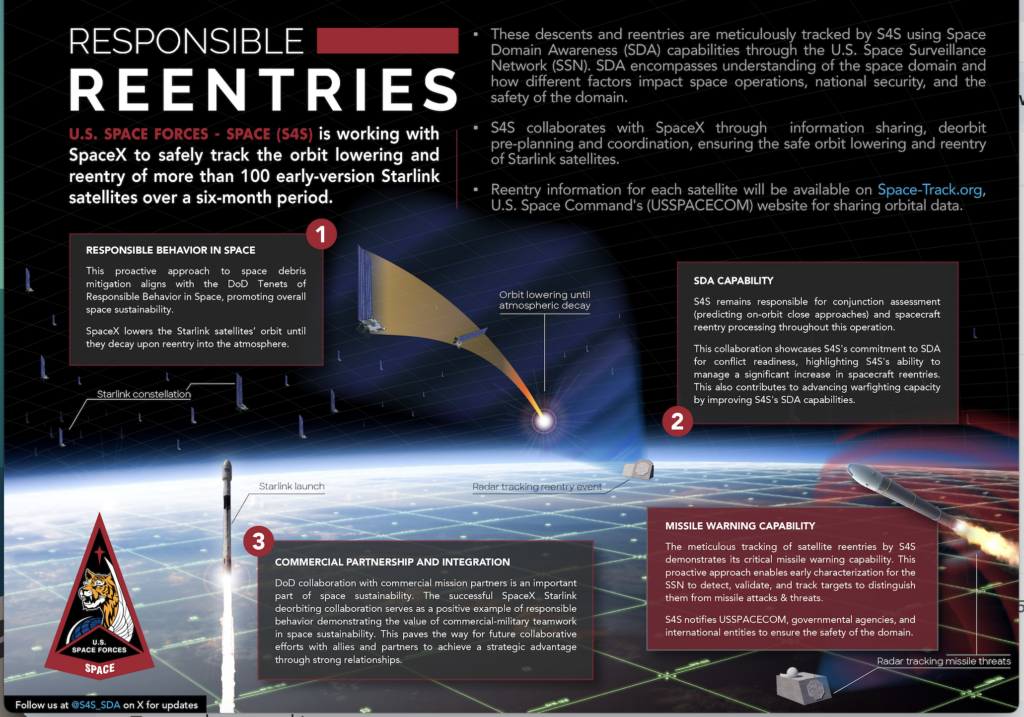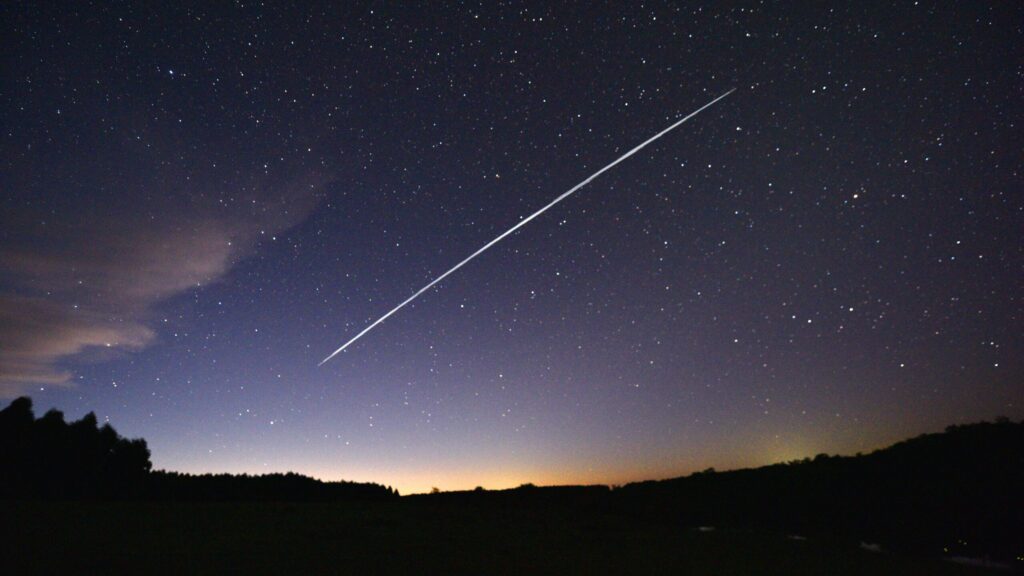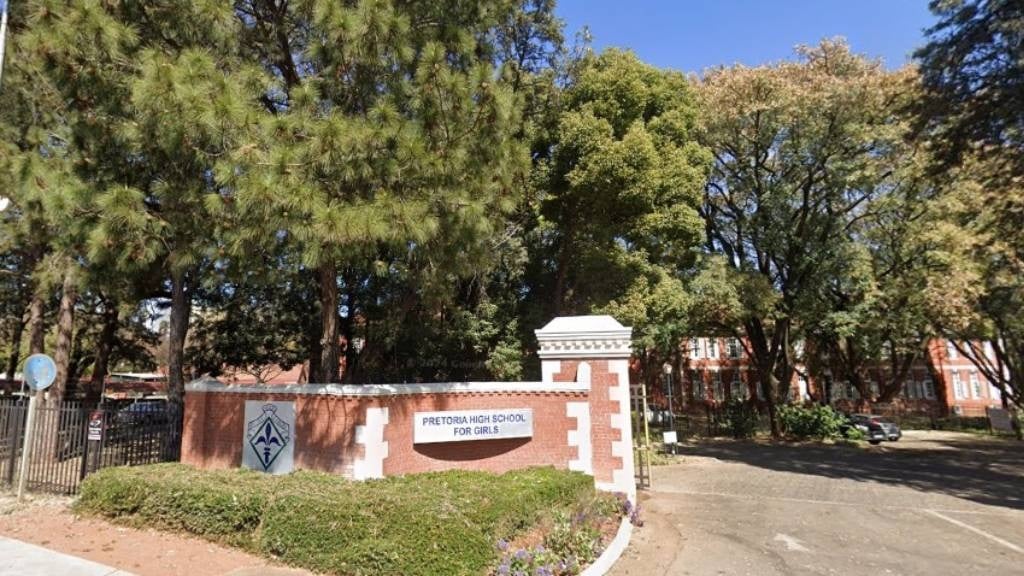A trail of a group of SpaceX’s Starlink satellites passing over Uruguay. (Photo by Mariana SUAREZ / AFP) (Photo by MARIANA SUAREZ/AFP via Getty Images)
WASHINGTON — The Space Force now is collaborating directly with SpaceX to closely monitor the company’s thousands of Starlink satellites as they lower their orbits and subsequently reenter the Earth’s atmosphere at the end of their lives — hopefully burning up, rather than raining bits and pieces down into the ocean or the ground or somebody’s house.
“U.S. Space Forces – Space or S4S is working with SpaceX to safely track the orbit lowering and reentry of Starlink satellites,” the service said in an announcement today.
S4S, created in December, is the Space Force’s operational component at US Space Command.
The announcement was accompanied by a fact sheet explaining what the service called a “proactive” and “collaborative” effort to keep tabs on Starlink reentries as SpaceX begins to de-orbit some 100 early variants.
“Reentry information for each satellite will be available on Space-Track.org, a public USSPACECOM website. S4S will continue to monitor and track artificial objects in space for spaceflight safety and the safety of the domain. Further details on the SpaceX Starlink satellites and the deorbiting operations can be obtained directly from SpaceX,” the announcement added.
SpaceX did not respond to a query by press time.
While SPACECOM routinely tracks satellites on their reentry trajectories via the Space Surveillance Network or telescopes and radar, a Space Force spokesperson said the goal of the fact sheet is to better inform the public as the Starlinks start to come down over the next six months.
“We are routinely tracking all reentries, but there has been an increase in reentries as SpaceX deliberately de-orbits several of their Starlink satellites. We want to make sure that people understand why there’s an increase and how collaboration with space system operators helps our team manage multiple reentries and improve our processes,” the spokesperson said.
“It’s really raining Starlinks right now,” Jonathan McDowell, an astronomer and astrophysicist at the Harvard–Smithsonian Center for Astrophysics, told Breaking Defense.
SpaceX had 6,078 Starlink satellites in low Earth orbit (LEO) as of May 2024, and 6,006 were still working, according to a May 30 report on Space.com. The Starlinks are engineered with a short lifetime of some three to five years; upon their decommissioning, SpaceX generally uses the satellites on-board propulsion systems to lower them down from their operational station at about 550 kilometers in altitude and kick start the natural re-entry process via the Earth’s gravitational pull.

Fact sheet from the Space Force on responsible satellite reentries.
The Federal Aviation Administration (FAA), which regulates space launch and reentry safety in the United States, in September issued a report to Congress [PDF] explaining that the rise of mega-constellations in LEO “poses an increased risk to people on Earth and aviation due to reentering debris.” The FAA report singled out SpaceX as a key contributor to that risk, stating that “over 85 percent of the expected risk to people on the ground and aviation from reentering debris in 2035.”
SpaceX unsurprisingly pushed back at the FAA report, calling it a “deeply flawed analysis” in an October letter to the agency and Congress, according to an Oct. 9 report in Space News.
McDowell, who is keeping track of Starlink re-entries and posting them in a “precipitation report” on X, said that up to now there have been no reported incidents of Starlink debris making it intact through its fiery descent to Earth.
But according to Moriba Jah, an astrodynamicist and cofounder of Privateer Space, SpaceX and NASA are both reconsidering the accuracy of the models they have used up to now to predict the likelihood that spacecraft reentry will result in junk hitting the ground — in part due to an uptick in SpaceX debris doing just that.
“NASA and SpaceX are re-evaluating the models about things that re-enter the atmosphere, human-made stuff, and their survival rates to the Earth’s surface because more and more people are finding SpaceX parts on their front lawns,” he said in a June 27 video posted on X (formerly Twitter).
The most recent impact incidents from debris attributed to SpaceX — in May when two large chunks of space junk were found in North Carolina — were not caused bits of Starlink satellites, rather pieces of the company’s Dragon spacecraft that has carried kit and crew to the International Space Station for NASA.



















Discussion about this post